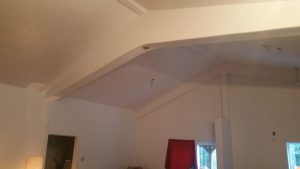Hansen Pole Buildings is currently designing a building for a golf course in Washington. While basically a two story storage building, it also includes a meeting room area which can be utilized for gatherings (I believe throwing darts was mentioned).
Anyhow – I digress….the real reason behind this article is a discussion of the solution to a fire protection issue along one sidewall of the new building.
 Most modern homes have gypsum wallboard, usually ½ inch thick on the walls. Visit any big box building material supply (honestly – most of us are compelled to visit one every time we drive by) and easily viewed are unit upon unit of white drywall. White drywall is the most cost-effective and most commonly used form of interior wall covering. It is manufactured in a variety of thicknesses, everything from quarter-inch to a full-inch thick, and code will dictate the thickness depending upon use and span.
Most modern homes have gypsum wallboard, usually ½ inch thick on the walls. Visit any big box building material supply (honestly – most of us are compelled to visit one every time we drive by) and easily viewed are unit upon unit of white drywall. White drywall is the most cost-effective and most commonly used form of interior wall covering. It is manufactured in a variety of thicknesses, everything from quarter-inch to a full-inch thick, and code will dictate the thickness depending upon use and span.
Fire-resistant gypsum board, also known as Type X, is required in certain locations — such as the one sidewall of this building, which is adjacent to another nearby structure. Attaching a new post frame garage to a home – good chance is a layer of Type X will be required between the two differing occupancies. It also may be required in other locations by local ordinance. Each state and each permit issuing jurisdiction within each state may have different building codes which mandate not only where Type X wallboard must be used, but also what minimum thickness of drywall must be used. There may even be stipulations regarding the type of fasteners — nails and glue, for instance — which must be used to secure the board.
For our particular case, the Building Official is looking for a single layer of 5/8 inch thick Type X drywall to be installed between the wall steel and the sidewall girts.
In the building we are designing with the wallboard on the outside of the wall framing, we recommended the use of moisture-resistant material. Drywall which is color-coded green is moisture-resistant. In residential applications, green drywall is used in areas of high humidity such as kitchens and in certain areas of bathrooms. Some municipalities do not allow the use of green drywall around showers and may restrict its use in laundry rooms.
For specifics as to what thickness and type of drywall should be used for a specific application, as well as how it should be attached, always consult with your local Building Department.
And, don’t forget; always properly dispose of any drywall waste material. Contact your local waste management






